A pressure transmitter or pressure sensor is a device that measures pressure in a liquid, fluid, or gas. Pressure transmitters are commonly used to measure pressure inside of industrial machinery in order to alert the user before a catastrophe occurs. They have many different uses, most of which are industrial or automotive in nature. A pressure transmitter is easily recognized as it is a round gauge with various colors that represent different pressure levels. While pressure transmitters are similar to other gauges, they are essential to many of the applications they are used for.
How a Pressure Transmitter Works
There are over 50 types of pressure transmitters that all work differently. Therefore, it is difficult to describe how all of them work within the confines of this article. For example, pressure transmitters that measure high speed changes in pressure depend on piezoelectric materials – materials that are capable of converting mechanical force in the form of pressure into an electric current. Gauge pressure sensors, on the other hand, rely on pure air pressure to move an actual meter and can be calibrated to a specific atmospheric pressure.
Applications
Pressure transmitters are used in a wide variety of applications. They are used in machinery to warn machine operators of high pressure levels before a disaster takes place. Pressure transmitters also ensure that machines do not apply too much or too little pressure during production. Pressure transmitters can be used in conjunction with other devices to measure depth, altitude, water flow, and even pressure loss in order to prevent leaks in a system.
Advantages
Pressure transmitters have several important advantages that other types of gauges do not. For example, pressure transmitters directly measure pressure levels as well as differences in pressure. Pressure transmitters can withstand virtually any environment and can even be completely submerged. They are made of piezoelectric materials, which are immune to both radiation and electromagnetic fields. Pressure transmitters can also be connected to other systems, such as electrical circuits, and can be calibrated to measure pressure relative to atmospheric pressure.
Disadvantages
Although pressure transmitters can be advantageous, they also have several disadvantages. For example, pressure transmitters are often expensive, although this differs for each version, and are usually difficult to find.




Follow Us!